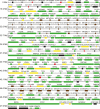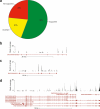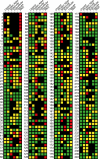Antibody-based protein profiling of the human chromosome 21
- PMID: 22042635
- PMCID: PMC3316724
- DOI: 10.1074/mcp.M111.013458
Antibody-based protein profiling of the human chromosome 21
Abstract
The Human Proteome Project has been proposed to create a knowledge-based resource based on a systematical mapping of all human proteins, chromosome by chromosome, in a gene-centric manner. With this background, we here describe the systematic analysis of chromosome 21 using an antibody-based approach for protein profiling using both confocal microscopy and immunohistochemistry, complemented with transcript profiling using next generation sequencing data. We also describe a new approach for protein isoform analysis using a combination of antibody-based probing and isoelectric focusing. The analysis has identified several genes on chromosome 21 with no previous evidence on the protein level, and the isoform analysis indicates that a large fraction of human proteins have multiple isoforms. A chromosome-wide matrix is presented with status for all chromosome 21 genes regarding subcellular localization, tissue distribution, and molecular characterization of the corresponding proteins. The path to generate a chromosome-specific resource, including integrated data from complementary assay platforms, such as mass spectrometry and gene tagging analysis, is discussed.
Figures






Similar articles
-
Affinity proteomics for systematic protein profiling of chromosome 21 gene products in human tissues.Mol Cell Proteomics. 2003 Jun;2(6):405-14. doi: 10.1074/mcp.M300022-MCP200. Epub 2003 Jun 9. Mol Cell Proteomics. 2003. PMID: 12796447
-
A genecentric Human Protein Atlas for expression profiles based on antibodies.Mol Cell Proteomics. 2008 Oct;7(10):2019-27. doi: 10.1074/mcp.R800013-MCP200. Mol Cell Proteomics. 2008. PMID: 18669619 Review.
-
RNA deep sequencing as a tool for selection of cell lines for systematic subcellular localization of all human proteins.J Proteome Res. 2013 Jan 4;12(1):299-307. doi: 10.1021/pr3009308. Epub 2012 Dec 20. J Proteome Res. 2013. PMID: 23227862
-
RNA- and antibody-based profiling of the human proteome with focus on chromosome 19.J Proteome Res. 2014 Apr 4;13(4):2019-27. doi: 10.1021/pr401156g. Epub 2014 Mar 12. J Proteome Res. 2014. PMID: 24579871
-
Antibody-based proteomics for human tissue profiling.Mol Cell Proteomics. 2005 Apr;4(4):384-93. doi: 10.1074/mcp.R500009-MCP200. Epub 2005 Feb 5. Mol Cell Proteomics. 2005. PMID: 15695805 Review.
Cited by
-
The human proteome - a scientific opportunity for transforming diagnostics, therapeutics, and healthcare.Clin Proteomics. 2012 Jul 3;9(1):6. doi: 10.1186/1559-0275-9-6. Clin Proteomics. 2012. PMID: 22583803 Free PMC article.
-
The HUPO Human Proteome Project (HPP), a Global Health Research Collaboration.Cent Asian J Glob Health. 2012 Sep 20;1(1):37. doi: 10.5195/cajgh.2012.37. eCollection 2012. Cent Asian J Glob Health. 2012. PMID: 29755865 Free PMC article.
-
Chromosome 19 annotations with disease speciation: a first report from the Global Research Consortium.J Proteome Res. 2013 Jan 4;12(1):135-50. doi: 10.1021/pr3008607. Epub 2012 Dec 18. J Proteome Res. 2013. PMID: 23249167 Free PMC article.
-
Advancing cell biology through proteomics in space and time (PROSPECTS).Mol Cell Proteomics. 2012 Mar;11(3):O112.017731. doi: 10.1074/mcp.O112.017731. Epub 2012 Feb 6. Mol Cell Proteomics. 2012. PMID: 22311636 Free PMC article.
-
YBEY is an essential biogenesis factor for mitochondrial ribosomes.Nucleic Acids Res. 2020 Sep 25;48(17):9762-9786. doi: 10.1093/nar/gkaa148. Nucleic Acids Res. 2020. PMID: 32182356 Free PMC article.
References
-
- (2010) The call of the human proteome. Nat. Methods 7, 661. - PubMed
-
- Hochstrasser D. (2008) Should the human proteome project be gene- or protein-centric? J. Proteome Res. 7, 5071. - PubMed
-
- Legrain P., Aebersold R., Archakov A., Bairoch A., Bala K., Beretta L., Bergeron J., Borchers C. H., Corthals G. L., Costello C. E., Deutsch E. W., Domon B., Hancock W., He F., Hochstrasser D., Marko-Varga G., Salekdeh G. H., Sechi S., Snyder M., Srivastava S., Uhlen M., Wu C. H., Yamamoto T., Paik Y. K., Omenn G. S. (2011) The human proteome project: Current state and future direction. Mol. Cell. Proteomics 10, 10.1074/mcp.M111.009993 - DOI - PMC - PubMed
-
- Agaton C., Galli J., Höidén Guthenberg I., Janzon L., Hansson M., Asplund A., Brundell E., Lindberg S., Ruthberg I., Wester K., Wurtz D., Höög C., Lundeberg J., Ståhl S., Pontén F., Uhlén M. (2003) Affinity proteomics for systematic protein profiling of chromosome 21 gene products in human tissues. Mol. Cell. Proteomics 2, 405–414 - PubMed
Publication types
MeSH terms
Substances
LinkOut - more resources
Full Text Sources
Molecular Biology Databases

